Characteristics of Thermal Parameters and Some Physical Properties of Mineral Eutectic Type: Petalite–Alkali Feldspars
Abstract
1. Introduction
2. Materials and Methods
2.1. Layout of Flux Raw Materials
2.2. High-Temperature Microscopy
2.3. Physical Parameters of the Melt
3. Results and Discussion
3.1. Characteristic Temperatures and Their Intervals
3.2. High-Temperature Viscosity, Density, Open Porosity, and Linear Shrinkage
4. Conclusions
- The first onset of shrinkage Ts (the beginning of sintering process) was observed for set 6 at about 900 °C.
- The eutectic melting point of the three-component mineral system; petalite (Petalite Std)–potassium feldspar (Norfloat Spar)–sodium feldspar (Albitte 5) occurred at 1346 °C at 20/60/20% weight proportions, respectively.
- The eutectic region occurs for sets 6 and 11 and 15 for petalite contents of 20%, 40%, and 60% by weight and a fixed sodium feldspar content of 20 wt %.
- An increase was observed in the density of samples in the centre of the triangular compositions in sets 6 and 11, with petalite contents of 20 wt % and 40 wt %, respectively.
- The lowest viscosity values of 1 × 105 and 1.26 × 105 were similarly observed for samples 6 and 11.
- In further works, the author will present the influence of Ca- and Mg-containing raw materials on the Li-Na-K flux system.
Funding
Institutional Review Board Statement
Informed Consent Statement
Data Availability Statement:
Conflicts of Interest
References
- Jaskula, B.W. Lithium. In Mineral Commodity Summaries; United States Geological Survey: Reston, VA, USA, 2019; pp. 98–99. [Google Scholar]
- Dessemond, C.; Lajoie-Leroux, F.; Soucy, G.; Laroche, N.; Magnan, J.-F. Spodumene: The Lithium Market, Resources and Processes. Minerals 2019, 9, 334. [Google Scholar] [CrossRef]
- Timoshevskii, A.N.; Ktalkherman, M.G.; Emel’Kin, V.A.; Pozdnyakov, B.A.; Zamyatin, A.P. High-temperature decomposition of lithium carbonate at atmospheric pressure. High Temp. 2008, 46, 414–421. [Google Scholar] [CrossRef]
- Liu, W.; Chu, G.-W.; Li, S.-C.; Bai, S.; Luo, Y.; Sun, B.-C.; Chen, J.-F. Preparation of lithium carbonate by thermal decomposition in a rotating packed bed reactor. Chem. Eng. J. 2019, 377, 119929. [Google Scholar]
- Shi, L.; Qu, T.; Liu, D.; Deng, Y.; Yang, B.; Dai, Y. Process of Thermal Decomposition of Lithium Carbonate. In Materials Processing Fundamentals; Lee, J., Wagstaff, S., Lambotte, G., Allanore, A., Tesfaye, F., Eds.; The Minerals, Metals & Materials Series; Springer: Cham, Switzerland, 2020. [Google Scholar] [CrossRef]
- Handke, M. Krystalochemia Krzemianów; Wydawnictwa AGH: Kraków, Poland, 2008. [Google Scholar]
- Černý, P.; London, D. Crystal chemistry and stablity of petalite. Tschermaks Mineral. Petrogr. Mitt. 1983, 31, 81–96. [Google Scholar] [CrossRef]
- Manecki, A. Mineralogia Szczegółowa; Mineral Press: Kraków, Poland, 2019. [Google Scholar]
- Murthy, M.K.; Hummel, F.A. Phase equilibria in the system lithium metasilicate-eukryptite. J. Am. Ceram. Soc. 1954, 37, 14–17. [Google Scholar] [CrossRef]
- Saalfeld, H. Struktur und Ausdehnungsverhalten von Li-Al-Silikate. Ber. Dtsch. Keram. Ges. 1961, 38, 281–286. [Google Scholar]
- Boyd, J.E. Pyrometric Properties of Spodumene-Felspar Mixtures. J. Am. Ceram. Soc. 1938, 21, 385–388. [Google Scholar] [CrossRef]
- Bach, D.; Krause, H. Low Thermal Expansion Glass Ceramics; Springer: Berlin, Germany, 2005. [Google Scholar]
- Bozdoǧan, I.; Göknel, I. Turkish feldspar. Ceramika/Ceramics 2004, 84, 115–118. [Google Scholar]
- Wyszomirski, P.; Gacki, F.; Szydłak, T. Turkish feldspar raw materials in polish production of ceramic tiles. Gospod. Surowcami Miner./Miner. Resour. Manag. 2012, 28, 5–18. [Google Scholar] [CrossRef]
- Wyszomirski, P.; Galos, K. Surowce Mineralne i Chemiczne Przemysłu Ceramicznego; AGH Uczelniane Wydawnistwo Naukowo-Dydaktyczne: Kraków, Poland, 2007. [Google Scholar]
- Xia, J.; Geng, R.; Chen, Z. The Effect of K-feldspar and Silica as Fluxing Agent on the Production Process of Phosphorus Furnace. Silicon 2019, 11, 233–239. [Google Scholar] [CrossRef]
- Peng, L.; Qin, S. Sintering behavior and technological properties of low-temperature porcelain tiles prepared using a lithium ore and silica waste. Minerals 2019, 9, 731. [Google Scholar] [CrossRef]
- Cioch, A.; Izak, P.; Stempkowska, A.; Thiery, D. Właściwości stopu układu: Spodumen-skaleń potasowy- skaleń sodowy. Szkło Ceram. 2009, 1, 29–32. [Google Scholar]
- Sokolář, R.; Keršnerová, L.; Šveda, M. The effect of different fluxing agents on the sintering of dry pressed porcelain bodies. J. Asian Ceram. Soc. 2017, 5, 290–294. [Google Scholar] [CrossRef]
- Stempkowska, A. Silicate Mineral Eutectics with Special Reference to Lithium. Materials 2021, 14, 4334. [Google Scholar] [CrossRef]
- Abdel Aziz, D.A.; El-Fadaly, E. Influence of Spodumene Added as a Fluxing Agent on the Properties of Alumina Porcelain Insulator. Interceram. Int. Ceram. Rev. 2017, 66, 238–243. [Google Scholar] [CrossRef]
- Carus, L.A.; Bragança, S. R Investigation of Spodumene-bearing Rock as a Flux for Bone China Production. Mater. Res. 2013, 16, 1398–1404. [Google Scholar] [CrossRef][Green Version]
- Serra, M.F.; Picicco, M.; Moyas, E.; Suárez, G.; Aglietti, E.F.; Rendtorff, N.M. Talc, Spodumene and Calcium Carbonate Effect as Secondary Fluxes in Triaxial Ceramic. Prop. Procedia Mater. Sci. 2012, 1, 397–402. [Google Scholar] [CrossRef][Green Version]
- Karrech, A.; Dong, M.; Skut, J.; Elchalakani, M.; Shahin, M.A. Management and valorisation of delithiated β-spodumene and its processing stream. Case Stud. Constr. Mater. 2021, 15, e00617. [Google Scholar] [CrossRef]
- Kavanagh, L.; Keohane, J.; Cabellos, G.G.; Lioyd, A.; Cleary, J. Global Lithium Sources—Industrial Use and Future in the Electric Vehicle Industry: A Review. Resources 2018, 7, 57. [Google Scholar] [CrossRef]
- Boccaccini, A.R.; Hamann, B. Review In Situ high-temperature optical microscopy. J. Mater. Sci. 1999, 34, 5419–5436. [Google Scholar] [CrossRef]
- Brenden, B.B.; Newkirk, H.W.; Batees, J.I. Principles of High-Temperature Microscopy. J. Am. Ceram. Soc. 2006, 43, 246–251. [Google Scholar] [CrossRef]
- Amarante, M.M.; Botelho de Sousa, A.; Machado Lite, M. Technical note processing a spodumene ore to obtain lithium concentrates for addition to glass and ceramic bodies. Miner. Eng. 1999, 12, 433–436. [Google Scholar] [CrossRef]
- Steller, R. Nowe modele opisu krzywych lepkości ścinania ustalonego cieczy nienewtonowskich. Polimery 2015, 10, 636–643. [Google Scholar] [CrossRef]
- Płoński, I. (Ed.) Technologia Szkła; Wyd. Arkady: Warszawa, Poland, 1987. [Google Scholar]
- Nowotny, W. Technologia Szkła; Wrocławskie Załady Graficzne: Wrocław, Poland, 1985. [Google Scholar]
- Zheng, Q.; Mauro, J.C.; Ellison, A.J.; Potuzak, M.; Yue, Y. Universality of the hig temperature viscosity limit of silicate liquids. Phys. Rev. B 2011, 83, 212202. [Google Scholar] [CrossRef]
- Raghunath, S. High-temperature viscosity measurements in slags. Master’s Thesis, School of Engineering, University of Queensland, Brisbane, Australia, 2007. [Google Scholar]
- Ojovan, M. Viscous flow and the viscosity of melts and glasses. Phys. Chem. Glasses 2012, 53, 143–150. [Google Scholar]
- Somiya, S. (Ed.) Handbook of Advanced Ceramics; Elsevier: Amsterdam, The Netherlands; Academic Press: Cambridge, MA, USA, 2013. [Google Scholar]
- Hrma, P. High-temperature viscosity of commercial glasses. Ceram. Silikáty 2005, 50, 57–66. [Google Scholar]
- Conte, S.; Zanelli, C.; Ardit, M.; Cruciani, G.; Dondi, M. Predicting Viscosity and Surface Tension at High Temperature of Porcelain Stoneware Bodies: A Methodological Approach. Materials 2018, 11, 2475. [Google Scholar] [CrossRef]
- Zanelli, C.; Raimondo, M.; Guarini, G.; Dondi, M. The vitreous phase of porcelain stoneware: Composition, evolution during sintering and physical properties. J. Non-Cryst. Solids 2011, 357, 3251–3260. [Google Scholar] [CrossRef]
- Lis, J.; Pampuch, R. Spiekanie Uczelniane Wydawnictwa Naukowo—Dydaktyczne; AGH: Kraków, Poland, 2000. [Google Scholar]
- Dosta, M.; Besler, R.; Ziehdorn, C.; Janβen, R.; Heinrich, S. Approximation of mechanical properties of sintered materials with discrete element metod. In Proceedings of the Powders & Grains 2017EPJ Web of Conferences, Montpellier, France, 3–7 July 2017; Volume 140. [Google Scholar] [CrossRef]
- Kitouni, S.; Harabi, A. Sintering and mechanical properties of porcelains prepared from algerian raw materials. Cerâmica 2011, 57, 453–460. [Google Scholar] [CrossRef]
- Dziubak, C. Intensyfikacjia procesu spiekania tworzyw ceramicznych—Przegląd. Sci. Work. Inst. Ceram. Build. Mater. 2017, 30, 7–56. [Google Scholar]
- Dessemond, C.; Soucy, G.; Harvey, J.-P.; Ouzilleau, P. Phase Transitions in the α-β-γ Spodumene Thermodynamic System and Impact of –Spodumene on the efciency of Lithium Extraction by Acid Leaching. Minerals 2020, 10, 519. [Google Scholar] [CrossRef]
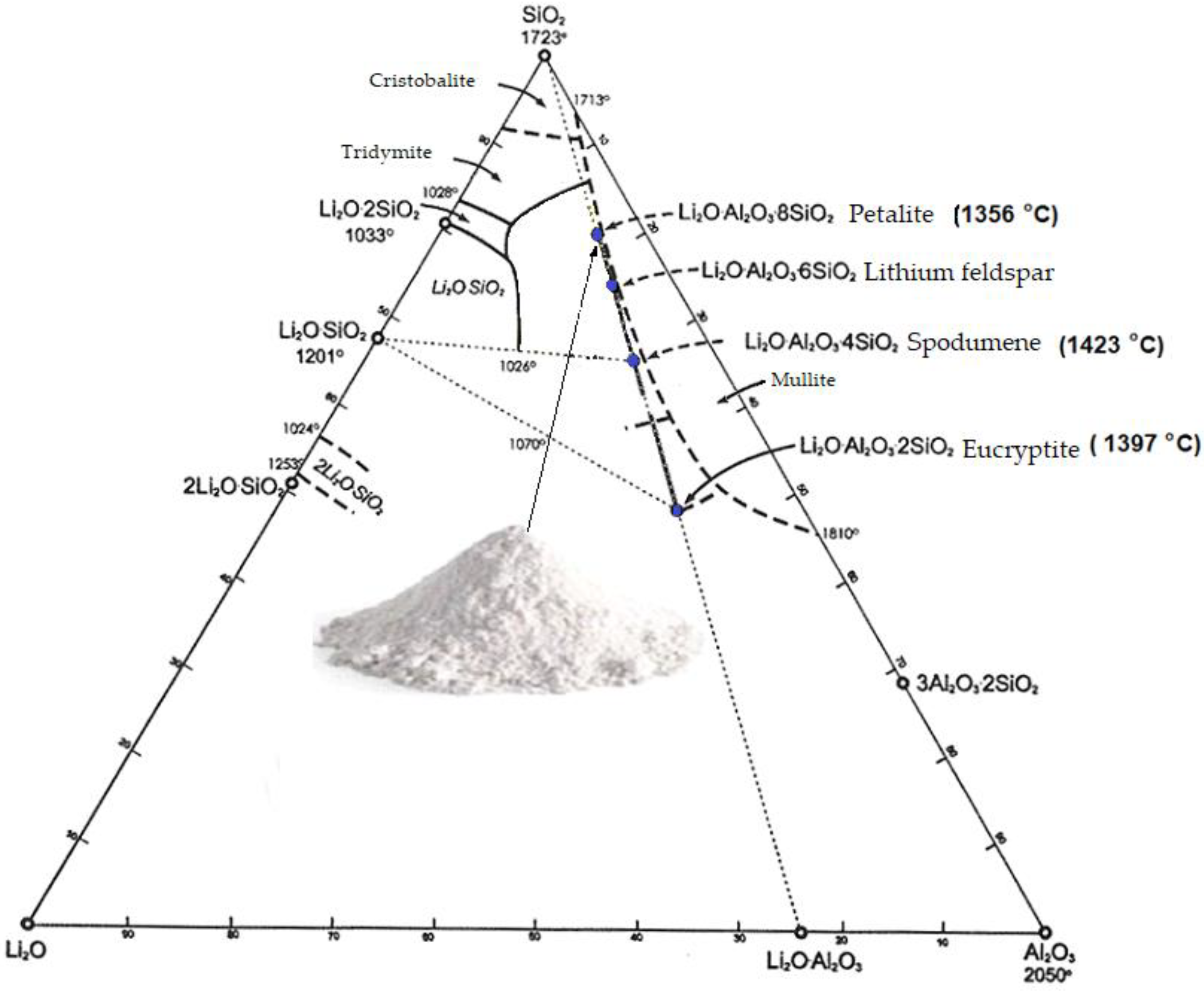
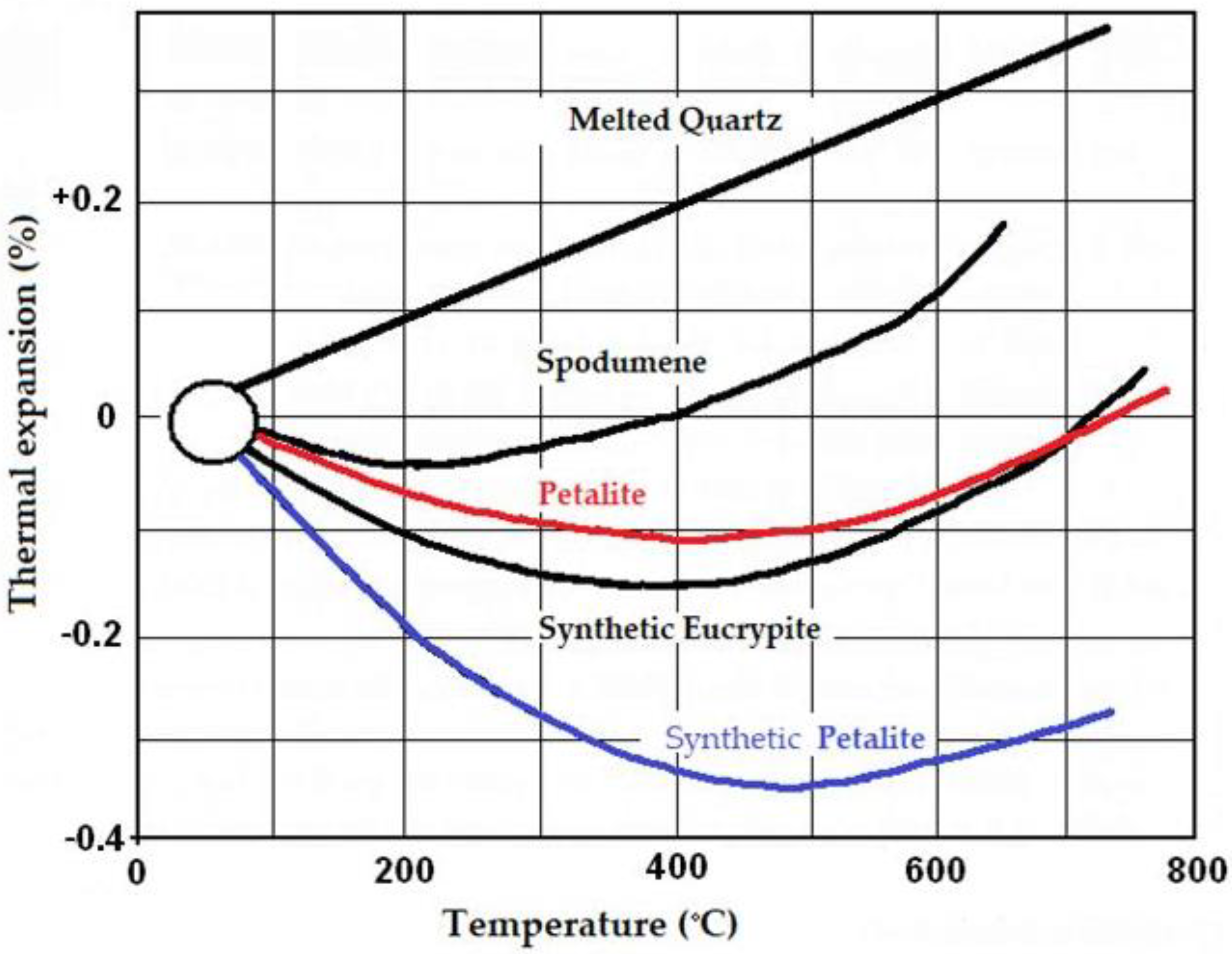
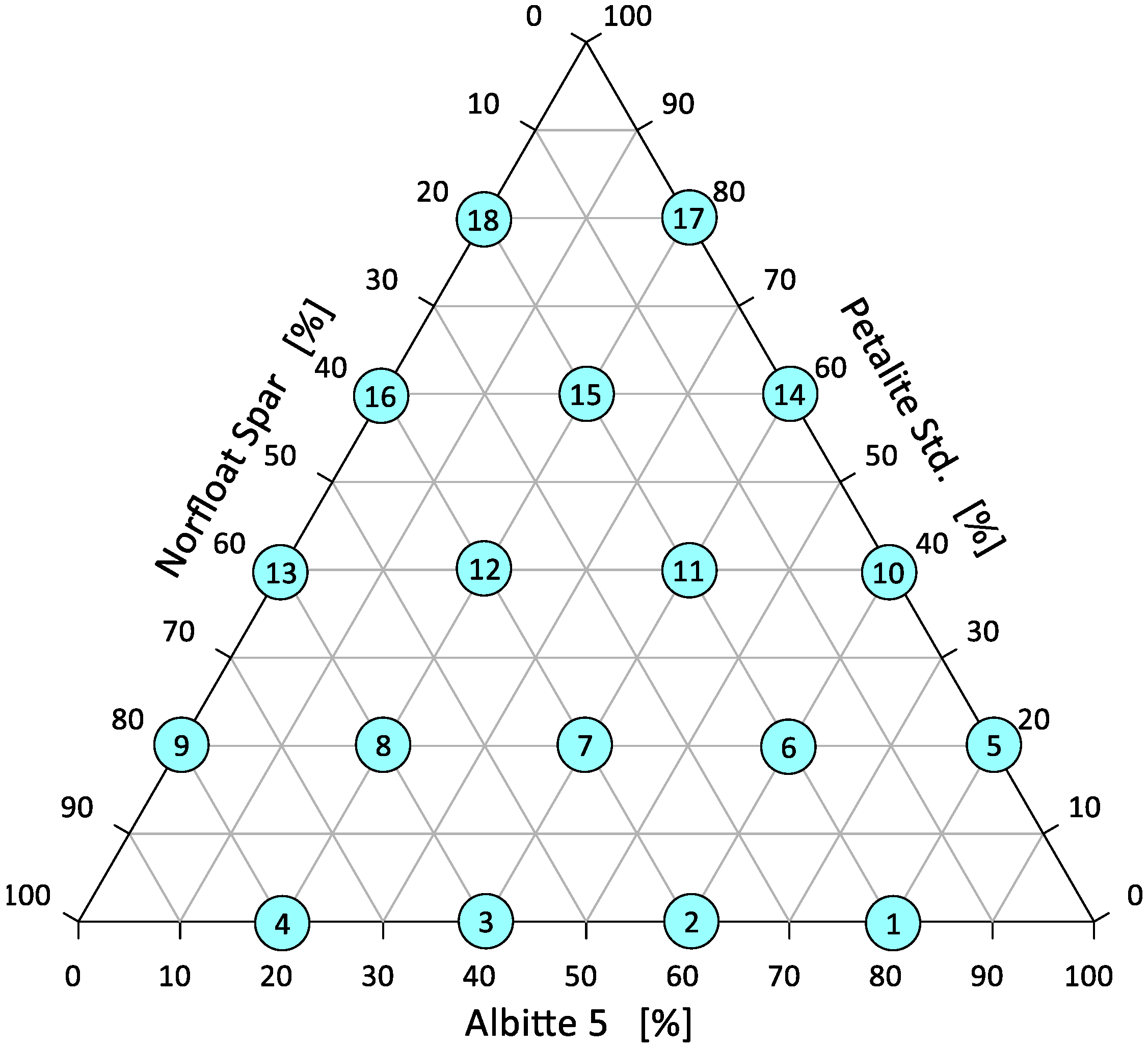

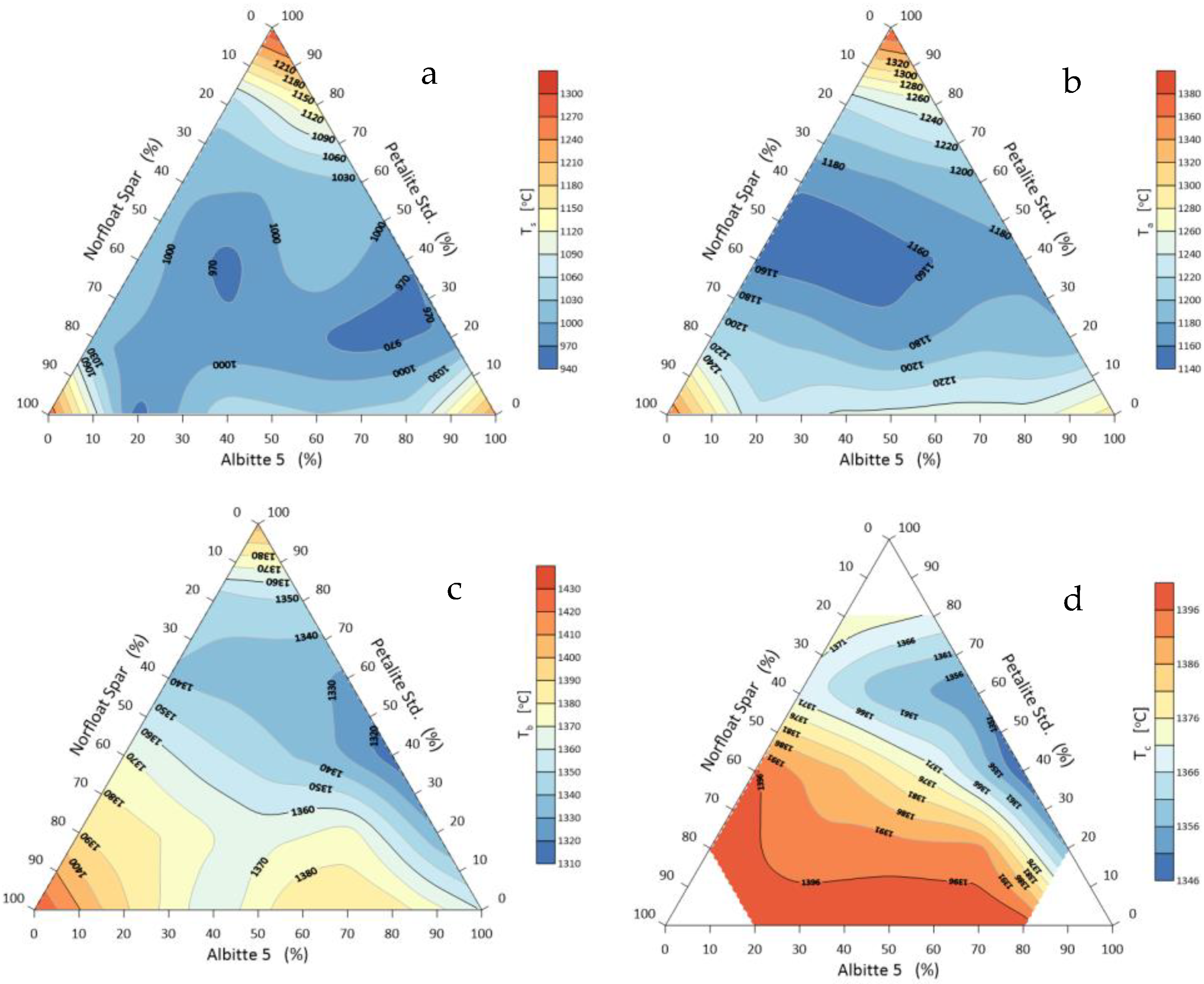
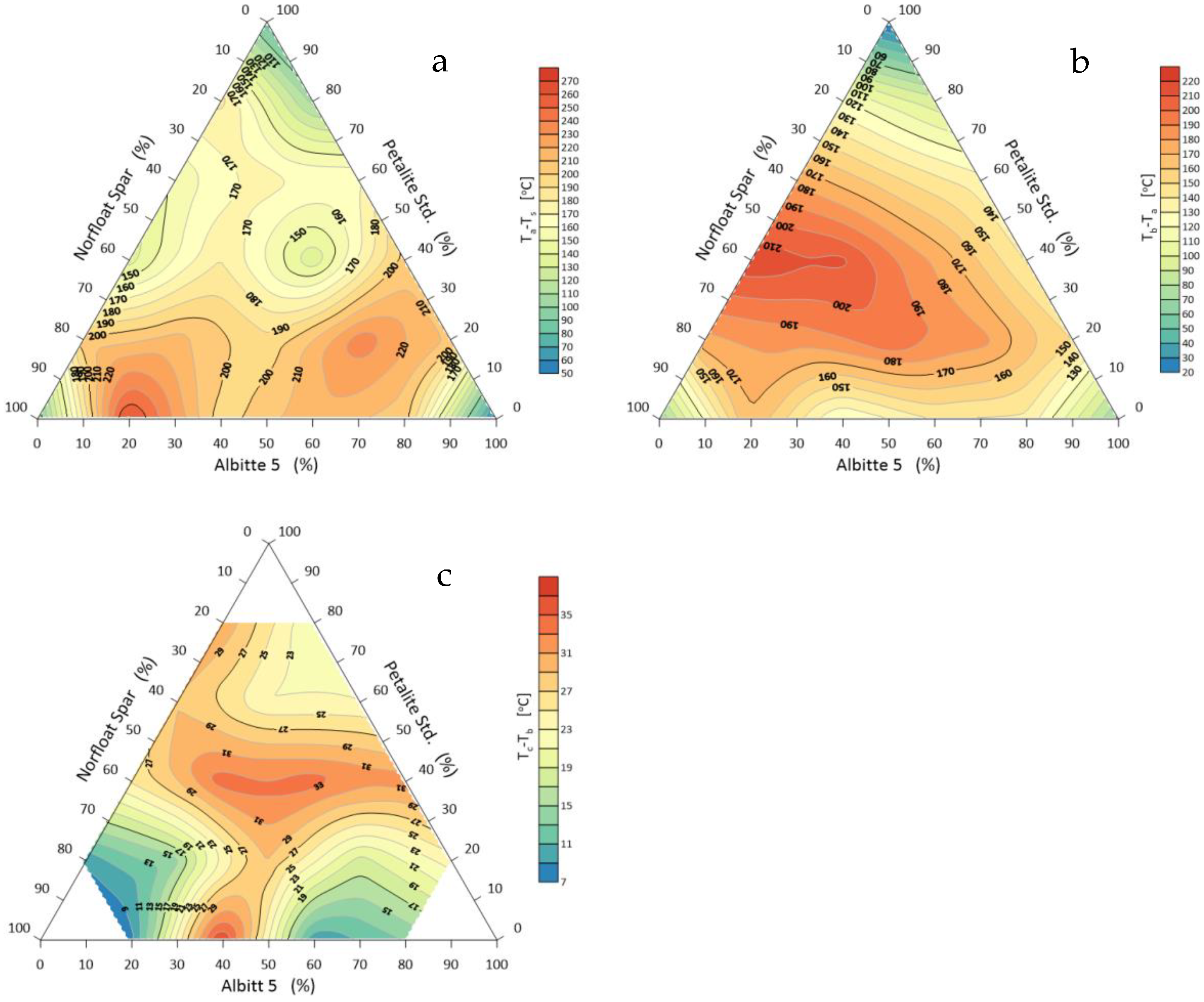
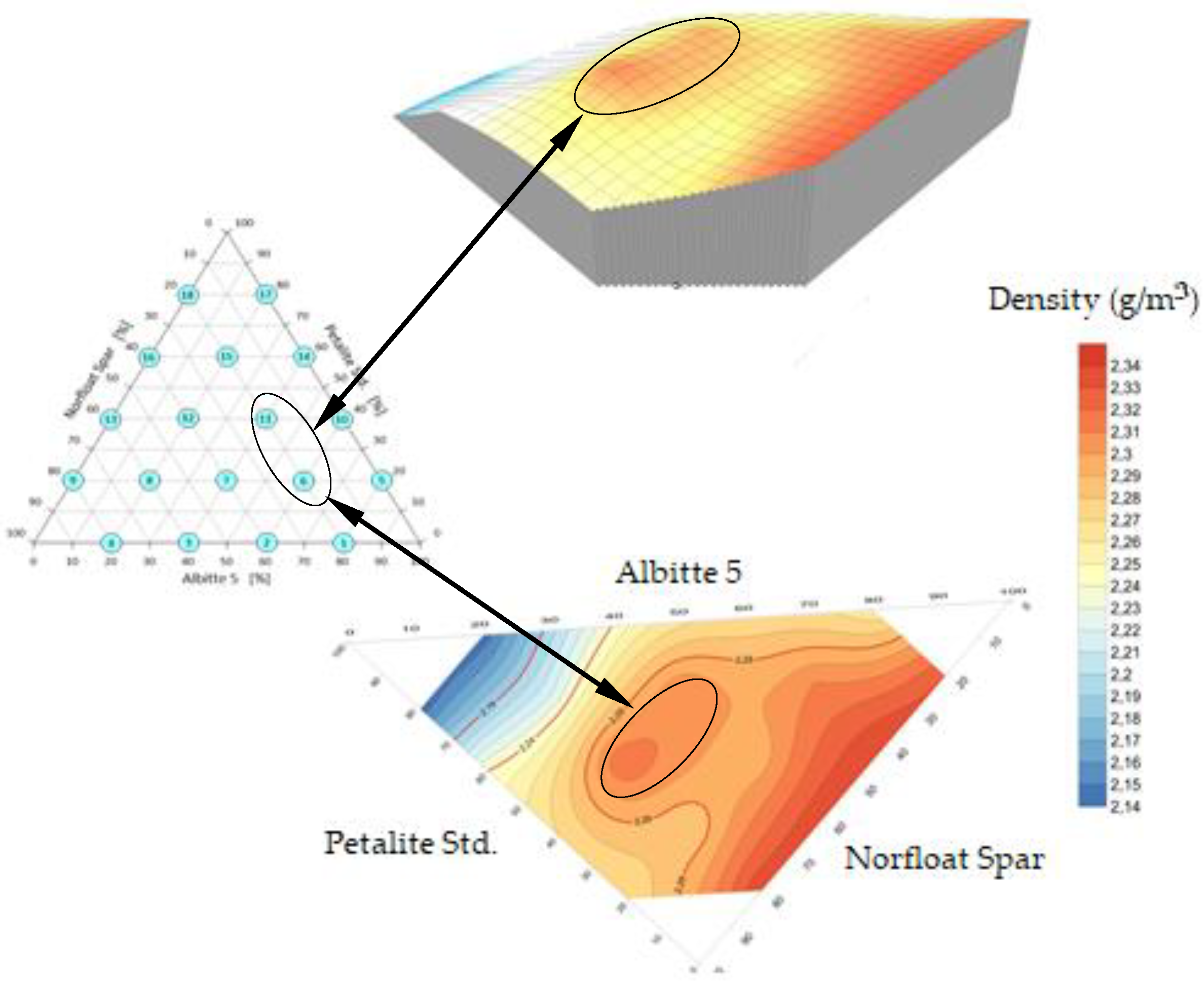
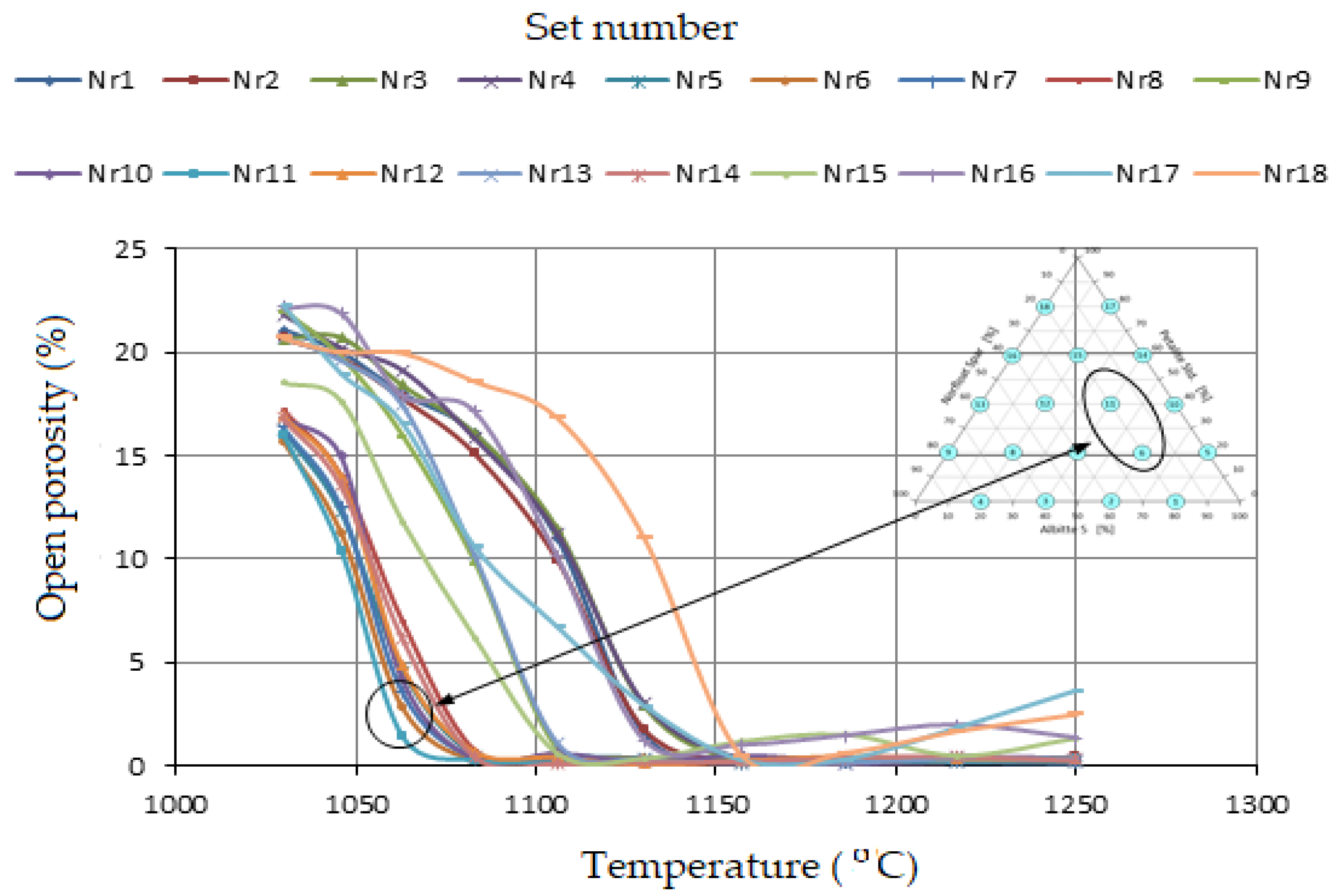
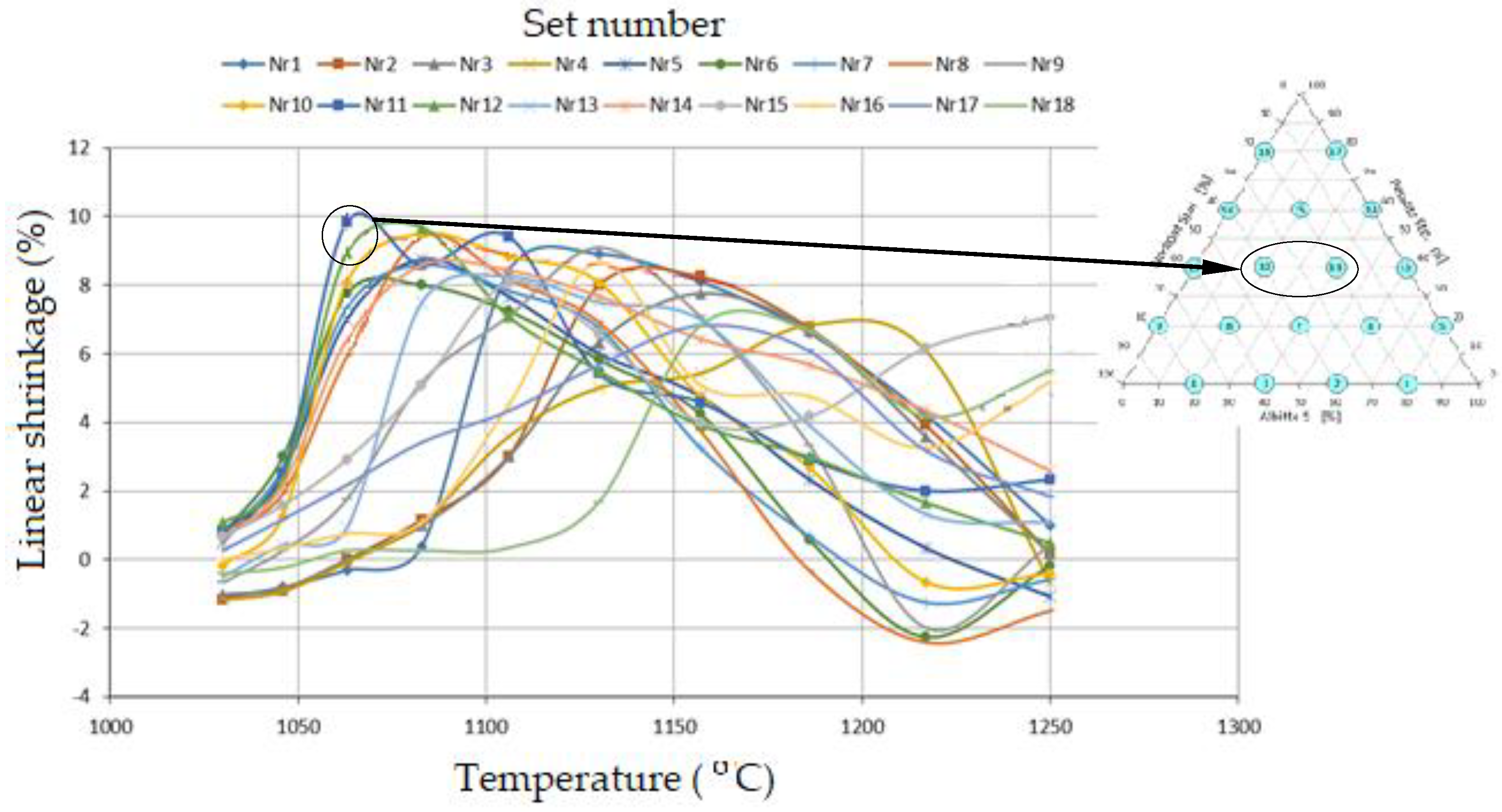
| Chemical Composition | Norfloat Spar | Albitte 5 | Petalite Std |
|---|---|---|---|
| wt % | |||
| SiO2 | 65.9 | 67.1 | 77.08 |
| Al2O3 | 18.5 | 18.8 | 16.56 |
| CaO | 0.5 | 0.6 | 0.14 |
| MgO | 0.1 | 1.3 | 0.04 |
| TiO2 | <0.05 | 0.36 | 0.01 |
| Fe2O3 | 0.23 | 0.7 | 0.05 |
| MnO | <0.05 | <0.05 | 0.01 |
| P2O5 | 0.06 | 0.13 | 0.01 |
| Na2O | 2.9 | 9.5 | 0.62 |
| K2O | 12.0 | 0.2 | 0.42 |
| Li2O | - | - | 4.28 |
| LOI | 1.02 | 1.49 | 0.76 |
| Set Number | High-Temperature Viscosity Pa∙s | Temperature at Specific Viscosity Level °C | ||||
|---|---|---|---|---|---|---|
| 1400 °C | 1500 °C | 1600 °C | η·1010 | η·108 | η·106 | |
| 1 | 1.26 × 1014 | 5.01 × 106 | 3.98 × 105 | 1446 | 1459 | 1540 |
| 2 | 5.01 × 1010 | 3.98 × 106 | 6.03 × 105 | 1415 | 1445 | 1550 |
| 3 | 1.26 × 108 | 3.63 × 106 | 5.89 × 105 | 1359 | 1407 | 1555 |
| 4 | 6.31 × 107 | 3.16 × 106 | 5.62 × 105 | 1350 | 1391 | 1556 |
| 5 | 1.29 × 107 | 1.26 × 106 | 7.41 × 105 | 1273 | 1340 | 1502 |
| 6 | 1.58 × 106 | 1.58 × 105 | 1.00 × 105 | 1317 | 1339 | 1425 |
| 7 | 2.00 × 107 | 1.41 × 106 | 7.08 × 105 | 1320 | 1375 | 1525 |
| 8 | 7.94 × 106 | 1.58 × 106 | 6.31 × 105 | 1250 | 1336 | 1510 |
| 9 | 5.01 × 106 | 4.47 × 105 | 1.78 × 105 | 1310 | 1349 | 1460 |
| 10 | 1.26 × 107 | 1.12 × 106 | 2.34 × 105 | 1300 | 1352 | 1499 |
| 11 | 7.94 × 106 | 5.62 × 105 | 1.26 × 105 | 1350 | 1370 | 1450 |
| 12 | 7.08 × 106 | 1.00 × 106 | 2.24 × 105 | 1247 | 1320 | 1475 |
| 13 | 6.31 × 106 | 7.08 × 105 | 2.24 × 105 | 1269 | 1325 | 1461 |
| 14 | 1.58 × 107 | 8.91 × 105 | 1.99 × 105 | 1352 | 1360 | 1480 |
| 15 | 6.31 × 106 | 7.94 × 105 | 1.82 × 105 | 1275 | 1339 | 1491 |
| 16 | 2.00 × 107 | 1.12 × 106 | 2.45 × 105 | 1336 | 1358 | 1502 |
| 17 | 3.98 × 106 | 1.26 × 106 | 7.90 × 105 | 1213 | 1250 | 1570 |
| 18 | 4.79 × 106 | 1.12 × 106 | 3.98 × 105 | 1299 | 1350 | 1512 |
Publisher’s Note: MDPI stays neutral with regard to jurisdictional claims in published maps and institutional affiliations. |
© 2021 by the author. Licensee MDPI, Basel, Switzerland. This article is an open access article distributed under the terms and conditions of the Creative Commons Attribution (CC BY) license (https://creativecommons.org/licenses/by/4.0/).
Share and Cite
Stempkowska, A. Characteristics of Thermal Parameters and Some Physical Properties of Mineral Eutectic Type: Petalite–Alkali Feldspars. Materials 2021, 14, 7321. https://doi.org/10.3390/ma14237321
Stempkowska A. Characteristics of Thermal Parameters and Some Physical Properties of Mineral Eutectic Type: Petalite–Alkali Feldspars. Materials. 2021; 14(23):7321. https://doi.org/10.3390/ma14237321
Chicago/Turabian StyleStempkowska, Agata. 2021. "Characteristics of Thermal Parameters and Some Physical Properties of Mineral Eutectic Type: Petalite–Alkali Feldspars" Materials 14, no. 23: 7321. https://doi.org/10.3390/ma14237321
APA StyleStempkowska, A. (2021). Characteristics of Thermal Parameters and Some Physical Properties of Mineral Eutectic Type: Petalite–Alkali Feldspars. Materials, 14(23), 7321. https://doi.org/10.3390/ma14237321






